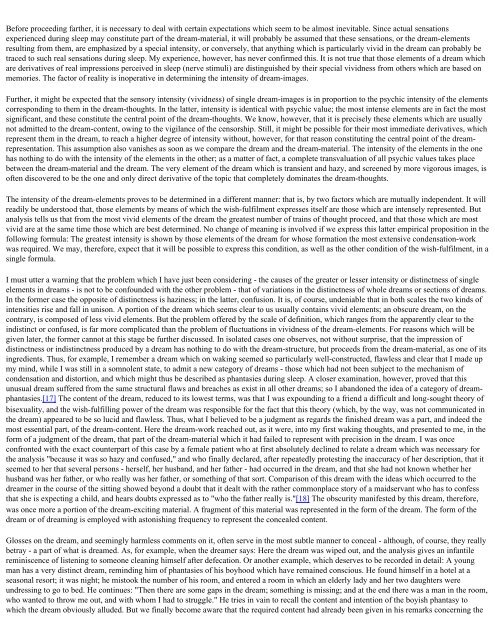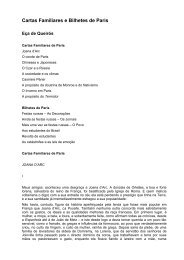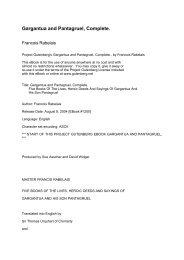The Interpretation of Dreams Sigmund Freud (1900)
The Interpretation of Dreams Sigmund Freud (1900)
The Interpretation of Dreams Sigmund Freud (1900)
You also want an ePaper? Increase the reach of your titles
YUMPU automatically turns print PDFs into web optimized ePapers that Google loves.
Before proceeding farther, it is necessary to deal with certain expectations which seem to be almost inevitable. Since actual sensations<br />
experienced during sleep may constitute part <strong>of</strong> the dream-material, it will probably be assumed that these sensations, or the dream-elements<br />
resulting from them, are emphasized by a special intensity, or conversely, that anything which is particularly vivid in the dream can probably be<br />
traced to such real sensations during sleep. My experience, however, has never confirmed this. It is not true that those elements <strong>of</strong> a dream which<br />
are derivatives <strong>of</strong> real impressions perceived in sleep (nerve stimuli) are distinguished by their special vividness from others which are based on<br />
memories. <strong>The</strong> factor <strong>of</strong> reality is inoperative in determining the intensity <strong>of</strong> dream-images.<br />
Further, it might be expected that the sensory intensity (vividness) <strong>of</strong> single dream-images is in proportion to the psychic intensity <strong>of</strong> the elements<br />
corresponding to them in the dream-thoughts. In the latter, intensity is identical with psychic value; the most intense elements are in fact the most<br />
significant, and these constitute the central point <strong>of</strong> the dream-thoughts. We know, however, that it is precisely these elements which are usually<br />
not admitted to the dream-content, owing to the vigilance <strong>of</strong> the censorship. Still, it might be possible for their most immediate derivatives, which<br />
represent them in the dream, to reach a higher degree <strong>of</strong> intensity without, however, for that reason constituting the central point <strong>of</strong> the dreamrepresentation.<br />
This assumption also vanishes as soon as we compare the dream and the dream-material. <strong>The</strong> intensity <strong>of</strong> the elements in the one<br />
has nothing to do with the intensity <strong>of</strong> the elements in the other; as a matter <strong>of</strong> fact, a complete transvaluation <strong>of</strong> all psychic values takes place<br />
between the dream-material and the dream. <strong>The</strong> very element <strong>of</strong> the dream which is transient and hazy, and screened by more vigorous images, is<br />
<strong>of</strong>ten discovered to be the one and only direct derivative <strong>of</strong> the topic that completely dominates the dream-thoughts.<br />
<strong>The</strong> intensity <strong>of</strong> the dream-elements proves to be determined in a different manner: that is, by two factors which are mutually independent. It will<br />
readily be understood that, those elements by means <strong>of</strong> which the wish-fulfilment expresses itself are those which are intensely represented. But<br />
analysis tells us that from the most vivid elements <strong>of</strong> the dream the greatest number <strong>of</strong> trains <strong>of</strong> thought proceed, and that those which are most<br />
vivid are at the same time those which are best determined. No change <strong>of</strong> meaning is involved if we express this latter empirical proposition in the<br />
following formula: <strong>The</strong> greatest intensity is shown by those elements <strong>of</strong> the dream for whose formation the most extensive condensation-work<br />
was required. We may, therefore, expect that it will be possible to express this condition, as well as the other condition <strong>of</strong> the wish-fulfilment, in a<br />
single formula.<br />
I must utter a warning that the problem which I have just been considering - the causes <strong>of</strong> the greater or lesser intensity or distinctness <strong>of</strong> single<br />
elements in dreams - is not to be confounded with the other problem - that <strong>of</strong> variations in the distinctness <strong>of</strong> whole dreams or sections <strong>of</strong> dreams.<br />
In the former case the opposite <strong>of</strong> distinctness is haziness; in the latter, confusion. It is, <strong>of</strong> course, undeniable that in both scales the two kinds <strong>of</strong><br />
intensities rise and fall in unison. A portion <strong>of</strong> the dream which seems clear to us usually contains vivid elements; an obscure dream, on the<br />
contrary, is composed <strong>of</strong> less vivid elements. But the problem <strong>of</strong>fered by the scale <strong>of</strong> definition, which ranges from the apparently clear to the<br />
indistinct or confused, is far more complicated than the problem <strong>of</strong> fluctuations in vividness <strong>of</strong> the dream-elements. For reasons which will be<br />
given later, the former cannot at this stage be further discussed. In isolated cases one observes, not without surprise, that the impression <strong>of</strong><br />
distinctness or indistinctness produced by a dream has nothing to do with the dream-structure, but proceeds from the dream-material, as one <strong>of</strong> its<br />
ingredients. Thus, for example, I remember a dream which on waking seemed so particularly well-constructed, flawless and clear that I made up<br />
my mind, while I was still in a somnolent state, to admit a new category <strong>of</strong> dreams - those which had not been subject to the mechanism <strong>of</strong><br />
condensation and distortion, and which might thus be described as phantasies during sleep. A closer examination, however, proved that this<br />
unusual dream suffered from the same structural flaws and breaches as exist in all other dreams; so I abandoned the idea <strong>of</strong> a category <strong>of</strong> dreamphantasies.[17]<br />
<strong>The</strong> content <strong>of</strong> the dream, reduced to its lowest terms, was that I was expounding to a friend a difficult and long-sought theory <strong>of</strong><br />
bisexuality, and the wish-fulfilling power <strong>of</strong> the dream was responsible for the fact that this theory (which, by the way, was not communicated in<br />
the dream) appeared to be so lucid and flawless. Thus, what I believed to be a judgment as regards the finished dream was a part, and indeed the<br />
most essential part, <strong>of</strong> the dream-content. Here the dream-work reached out, as it were, into my first waking thoughts, and presented to me, in the<br />
form <strong>of</strong> a judgment <strong>of</strong> the dream, that part <strong>of</strong> the dream-material which it had failed to represent with precision in the dream. I was once<br />
confronted with the exact counterpart <strong>of</strong> this case by a female patient who at first absolutely declined to relate a dream which was necessary for<br />
the analysis "because it was so hazy and confused," and who finally declared, after repeatedly protesting the inaccuracy <strong>of</strong> her description, that it<br />
seemed to her that several persons - herself, her husband, and her father - had occurred in the dream, and that she had not known whether her<br />
husband was her father, or who really was her father, or something <strong>of</strong> that sort. Comparison <strong>of</strong> this dream with the ideas which occurred to the<br />
dreamer in the course <strong>of</strong> the sitting showed beyond a doubt that it dealt with the rather commonplace story <strong>of</strong> a maidservant who has to confess<br />
that she is expecting a child, and hears doubts expressed as to "who the father really is."[18] <strong>The</strong> obscurity manifested by this dream, therefore,<br />
was once more a portion <strong>of</strong> the dream-exciting material. A fragment <strong>of</strong> this material was represented in the form <strong>of</strong> the dream. <strong>The</strong> form <strong>of</strong> the<br />
dream or <strong>of</strong> dreaming is employed with astonishing frequency to represent the concealed content.<br />
Glosses on the dream, and seemingly harmless comments on it, <strong>of</strong>ten serve in the most subtle manner to conceal - although, <strong>of</strong> course, they really<br />
betray - a part <strong>of</strong> what is dreamed. As, for example, when the dreamer says: Here the dream was wiped out, and the analysis gives an infantile<br />
reminiscence <strong>of</strong> listening to someone cleaning himself after defecation. Or another example, which deserves to be recorded in detail: A young<br />
man has a very distinct dream, reminding him <strong>of</strong> phantasies <strong>of</strong> his boyhood which have remained conscious. He found himself in a hotel at a<br />
seasonal resort; it was night; he mistook the number <strong>of</strong> his room, and entered a room in which an elderly lady and her two daughters were<br />
undressing to go to bed. He continues: "<strong>The</strong>n there are some gaps in the dream; something is missing; and at the end there was a man in the room,<br />
who wanted to throw me out, and with whom I had to struggle." He tries in vain to recall the content and intention <strong>of</strong> the boyish phantasy to<br />
which the dream obviously alluded. But we finally become aware that the required content had already been given in his remarks concerning the









